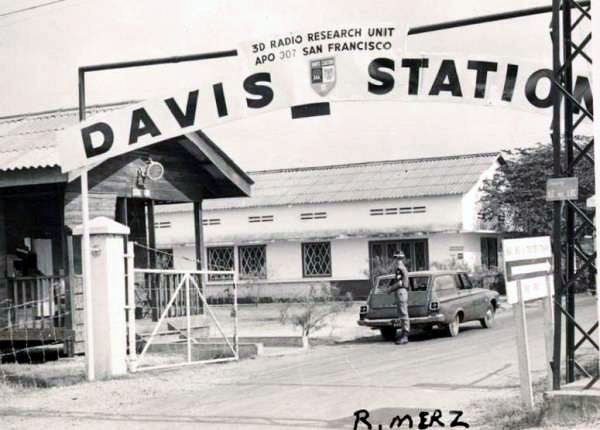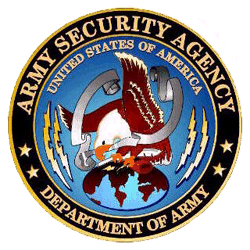Active 1945–76 Founded 1945 | ||
 | ||
Motto Semper Vigilis Latin Vigilant Always Role Communications Intelligence; Electronic Intelligence; signals intelligence; Communications Security Similar United States Army, military intelligence Corps, II Field Force - Vietnam, Military Police Corps, Army of the Republic of Vietnam | ||
Army Security Agency Song
The United States Army Security Agency (ASA) was the United States Army's signals intelligence branch. The Latin motto of the Army Security Agency was Semper Vigilis (Vigilant Always), which echoes Thomas Jefferson's declaration that "The price of freedom is eternal vigilance." The Agency existed between 1945 and 1976 and was the successor to Army signals intelligence operations dating back to World War I. ASA was under the operational control of the Director of the National Security Agency (DIRNSA), located at Fort Meade, Maryland; but had its own tactical commander at Headquarters, ASA, Arlington Hall Station, Virginia. Besides intelligence gathering, it had responsibility for the security of Army communications and for electronic countermeasures operations. In 1977, the ASA was merged with the US Army's Military Intelligence component to create the United States Army Intelligence and Security Command (INSCOM).
Contents

History
Composed of soldiers trained in military intelligence, the ASA was tasked with monitoring and interpreting military communications of the Soviet Union, the People's Republic of China, and their allies and client states around the world. The ASA was directly subordinate to the National Security Agency and all major field stations had NSA technical representatives present.

All gathered information had time-sensitive value depending on its importance and classification. Information was passed through intelligence channels within hours of intercept for the lowest-priority items, but in as little as 10 minutes for the most highly critical information.

ASA personnel were stationed at locations around the globe, wherever the United States had a military presence – publicly acknowledged or otherwise. In some cases, such as Eritrea, it was the primary military presence. One former Field Station, outside of Harrogate, England, in what is now North Yorkshire, was a primary listening post that was subsequently turned over to the British and became an RAF station. It is called RAF Menwith Hill and has been the site of peace protests.
Vietnam War
Although not officially serving under the ASA name, covertly designated as Radio Research, ASA personnel of the 3rd Radio Research Unit were among the earliest U.S. military personnel in Vietnam; 3rd later grew to become the 509th Radio Research Group.
The first ASA soldier to be a battlefield fatality of the Vietnam War was Specialist 4 James T. Davis (from Livingston, Tennessee) who was killed on 22 December 1961, on a road near the old French Garrison of Cau Xang. He had been assigned to the 3rd Radio Research Unit at Tan Son Nhut Airport near Saigon, along with 92 other members of his unit. Davis Station, at Tan Son Nhut, was named after him. Although President Lyndon Johnson later termed Davis "the first American to fall in the defense of our freedom in Vietnam", a look at the Vietnam Veterans' memorial shows that he was nowhere near the first U.S. fatality.
Most ASA personnel processed in country through Davis Station. Others attached to larger command structures prior to transport to Vietnam processed in with those units. ASA personnel were attached to Army infantry and armored cavalry units throughout the Vietnam War. Some teams were also attached to the Studies and Observation Group of Military Assistance Command Vietnam and special forces units. Assigned to the 5th Special Forces Group (Airborne) based out of Nha Trang was the 4O3rd Radio Research Group, Special Operations Detachment (SOD). SODiers deployed to Operational Detachment base camps throughout South Vietnam. Other teams were independent of other army units, such as the 313th Radio Research Battalion at Nha Trang. ASA personnel remained in Vietnam after the 1973 pullout of US Army combat forces and remained present until the Fall of Saigon in April 1975.
Personnel
ASA MOSs include:
Voice intercept operators, who are usually linguists with MOS 98G (plus a four character suffix (pLnn) to indicate proficiency level and language code), morse code high speed intercept operators ("Ditty Boppers", MOS 058 and later "Hogs" for their 05H designation), non-morse (teletype and voice) intercept operators (05K), communications security/signal security specialists (05G, "Goofies") direction-finding equipment operators ("Duffys" for their 05D designation), computer system operators (74E) who operated equipment at the NSA headquarters and out in the field; A K3 attached to the primary MOS meant the person was qualified to operate Jamming equipment. There was an additional MOS known as a 93G-Microbarograph specialist. The last class for this MOS was taught at Ft. Devens 1968-1969.Telecommunications Center Specialist (teletype) – 'Tape Ape' – (72B w/D1 designator), Radio Teletype (RTTY) w/Morse Code qualifier (05C), Cryptanalysis/Cryptanalytic Technician (crippies),(98B), communications traffic analysts (98C), voice intercept operators (Monterey-Marys)(98G) non-communications intercept/analysts (98J – radar and telemetry) electronic cryptographic maintenance technicians(32F-G, and 33S), and Specialized Teletypewriter Equipment Repairman (31J B3).Electronic Maintenance MOS' included 32D Technical Controller, 33B intercept equipment repairman, 33C Intercept Receiver Repairman, 33D Intercept Record System Repairmen, 33E20 Microbarographic Equipment Repairman, 33F Digital Demultiplex Intercept Systems Repairman, 34F Digital Systems Terminal Equipment Repairman and 33G Electronics Countermeasures System Repairmen and a 44 man Special Operations Detachment or field teams to conduct clandestine combat operations, among others. ASA had its own separate training facilities, Military Police force, communication centers and chain of command. In 1976, all 33 MOS designations were consolidated into one field, 33S Electronic Repairman. The designation became Electronic Warfare Intercept Systems Repairman.Other specialists intercepted and analyzed radar transmissions or intercepted communications and data transmissions from missiles and satellites.These occupations, which required a top secret clearance (or higher) with Special Intelligence/crypto special clearances, were essential to U.S. Cold War efforts. ASA units usually operated in four groups called 'tricks', using revolving shifts to provide coverage twenty-four hours a day, seven days a week. ASA troops were not allowed to discuss their operations with outsiders – in fact, they could not talk among themselves about their duties unless they were in a secure location. Even today, some of the missions still cannot be discussed. ASA personnel processing out of sensitive operations were debriefed and signed a document specifying a thirty-year elapsed time before they could discuss what they had done or observed. Note: Information other than XGDS (eXempt from General Declassification Schedule) is automatically declassified after 30 years.
Owing to the sensitivity of the information with which they worked, ASA personnel were subject to travel restrictions during and sometimes after their time in service. The activities of the ASA have only recently been partially declassified. This turn of events has been accompanied by the appearance of a small number of ASA memoirs and novels (see the list below).
